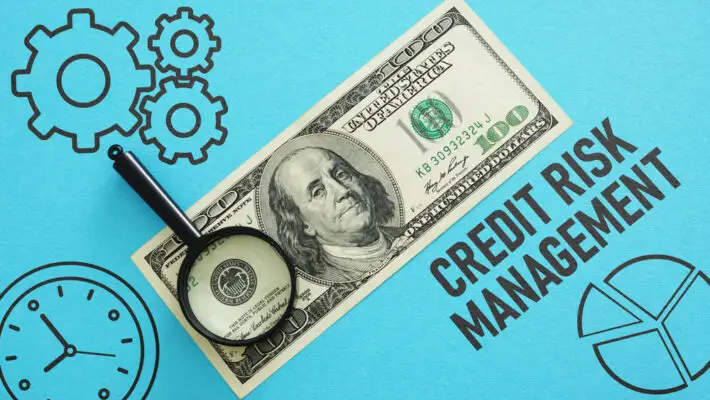Credit risk, or default risk, is the potential loss a lender or investor may incur if a borrower fails to repay a loan or fulfil contractual obligations. In other words, the risk of not receiving the owed principal and interest can lead to an interruption of cash flows and increased collection costs.
Credit risk can be associated with various transactions, including loans, bonds, or credit-dependent derivatives like credit default swaps. In financial institutions, managing credit risk is a critical component of risk management.
It involves techniques for assessing the creditworthiness of borrowers, setting credit limits, pricing for risk, and diversifying the risk through spreading exposures across different borrowers or sectors.
From the perspective of the broader economy, high levels of credit risk can contribute to systemic risks in the financial system. For instance, if a significant number of borrowers defaulted on their loans, this could lead to financial instability. Hence, credit risk is a major consideration for financial institutions and regulatory authorities.
Credit risk is a major concern for banks as it threatens their financial stability. Banks are exposed to various credit risks, such as default, counterparty, and concentration risks, resulting in significant losses if not managed effectively. Therefore, banks must adopt effective strategies and techniques to mitigate credit risk.
In this article, we will explore how banks manage credit risk by examining the risks they face and the tools and techniques they use to mitigate them.
We will also discuss the importance of credit analysis in assessing borrower creditworthiness and explain how credit scoring models are used to evaluate borrower credit risk.
Additionally, we will highlight how setting appropriate credit limits based on the borrower’s risk profile can help minimize potential losses due to default or other non-payment forms.

Types of Credit Risks Faced by Banks
Credit risk is the potential loss that arises when a borrower fails to repay a loan or meet its contractual obligations.
Banks face various types of credit risks, including default, counterparty, concentration, and country risks. Default risk occurs when borrowers fail to make timely payments on their debt obligation.
Counterparty risk arises from the possibility that the other party in a financial transaction may not fulfil its obligations.
Concentration risk arises when banks have too much exposure to one particular industry or borrower. In such cases, a downturn in the economy or industry can lead to significant bank losses. Country risk refers to the political and economic instability of countries where borrowers are located.
The impact of macroeconomic factors on credit risk cannot be ignored since they play an important role in determining whether borrowers can repay their loans.
Economic recessions or inflationary pressures can increase unemployment rates leading to defaults; hence, lenders must factor in these uncertainties while assessing creditworthiness.
Managing credit risks is essential for banks as it helps them avoid significant losses that can arise due to non-repayment by borrowers. Various types of credit risks exist, such as default, counterparty, concentration, and country risks, which need careful financial institutions management.
Techniques and Tools Used to Mitigate Credit Risk
Implementing risk mitigation strategies using advanced techniques and tools has become crucial to the banking industry’s efforts to minimize potential credit losses.
One common technique banks use is risk diversification, which involves spreading lending activities across various industries and sectors. This approach ensures that the bank’s loan portfolio is not overly concentrated in any one area, reducing the impact of a default in any specific sector.
Another tool utilized by banks to manage credit risk is collateral management. Collateral refers to assets pledged by borrowers as security for loans. Banks can reduce their exposure to credit risk by requiring collateral as they have an asset that can be sold or liquidated in case of non-payment.
However, banks need to ensure that the value of the collateral remains sufficient to cover the outstanding debt throughout the life of a loan.
In addition to these techniques and tools, banks also use credit scoring models and stress testing methodologies to assess potential risks associated with lending activities.
Credit scoring models analyze historical data on borrower behaviour and financial performance. At the same time, stress testing evaluates how well a bank’s loan portfolio would perform under adverse economic conditions such as a recession or market downturn.
Credit Analysis: Assessing Borrower Creditworthiness
Credit analysis is a fundamental process for assessing potential borrowers’ financial strength and ability to meet their debt obligations. It involves evaluating their credit history, income level, debt-to-income ratio, and overall financial stability.
The primary objective of credit analysis is to determine the likelihood that a borrower will default on their loan or fail to make timely payments. One critical tool used in credit analysis is the credit report.
A credit report provides detailed information about an individual’s borrowing and repayment history, including any delinquencies or defaults.
Additionally, analyzing financial ratios such as debt-to-equity, current ratio, and profit margins can help lenders assess borrowers’ ability to repay debts with their existing resources.
Proper credit analysis enables banks to effectively manage credit risk by identifying potential problem loans early on and making informed lending decisions based on the borrower’s financial standing.
Credit Scoring Models: Evaluating Borrower Credit Risk
Evaluating borrower credit risk using credit scoring models is akin to a diagnostic tool that uses mathematical algorithms to predict the likelihood of loan default based on historical data and other factors.
Banks rely on these models to assess the creditworthiness of borrowers and make informed lending decisions. Credit scoring models incorporate various data analytics techniques, such as machine learning, to identify patterns in the borrower’s financial history, demographics, and other relevant information.
Credit scoring models typically consider four key elements when assessing borrower credit risk. First, they evaluate the borrower’s payment history by analyzing their repayment behaviour.
Second, they examine the amount of outstanding debt compared to available credit limits – the credit utilization ratio – which provides insight into how much debt a borrower can handle without defaulting.
Third, they look at the length of the borrower’s credit history; a longer history tends to indicate better financial stability and reliability. Finally, they consider various demographic factors like age, income level, employment status etc., which may impact an individual’s ability or willingness to repay their loans.
Banks also employ sophisticated analytical tools like neural networks and decision trees in developing effective credit scoring models that accurately predict loan defaults while reducing false positives.
Machine learning algorithms enable banks to analyze large volumes of data more efficiently and improve model accuracy through continuous refinement based on new data inputs or changes in market conditions.
They also leverage big data analytics technologies effectively for assessing borrower risk profiles with greater objectivity than traditional methods banks can significantly reduce lending risks while improving customer experience through faster processing times and reduced documentation requirements.
Setting Credit Limits Based on Risk Profile
Assessing borrower credit risk is only the first step in banks’ lending decisions; setting appropriate credit limits based on each borrower’s unique risk profile is equally critical. Here’s a simplified overview of how this process typically works:
Credit Scoring and Risk Assessment: This is the first step in the process, where the customer’s creditworthiness is evaluated. Information from credit bureaus, income details, employment history, existing debts, and payment history are used to generate a credit score. Higher scores generally indicate lower risk.
Risk Segmentation: Customers are segmented into risk categories based on their credit score and other relevant information. For example, those with high credit scores and stable incomes might be categorized as low risk, while those with lower or unstable incomes might be considered medium or high risk.
Determining Credit Limits: Each risk category will have a range of associated credit limits determined by the financial institution’s risk appetite and lending policies. Customers in lower-risk categories are generally eligible for higher credit limits, while those in higher-risk categories are given lower limits.
Lower-risk customers are less likely to default on their repayments, so the financial institution is willing to lend them more.
Ongoing Review and Adjustment: The customer’s risk profile and credit limit should be reviewed periodically. If the customer’s situation changes – for example, if their credit score improves significantly or if they experience financial difficulties – the credit limit can be adjusted accordingly.
Credit limit strategies must be developed to ensure the bank does not lend more than a borrower can reasonably repay while accommodating their financial needs and goals.
Various methods for determining a suitable credit limit include using debt-to-income ratios or evaluating the borrower’s past payment history. Risk assessment techniques play a significant role in determining appropriate credit limits for borrowers.
These techniques involve evaluating various factors such as income stability, employment status, and credit history to determine the probability of default. Using these techniques, banks can assign different levels of risk to each borrower and set corresponding credit limits accordingly.
Banks also need to consider how to manage changes in borrowers’ risk profiles over time. Periodically reviewing borrowers’ financial situations ensures that their credit limits align with their current level of risk.
This involves continuous monitoring of changes in income, expenses, payment history, and other relevant factors that may impact the borrower’s ability to repay debts.
Frequently Asked Questions
What is the role of credit risk management in the overall business strategy of a bank?
Credit risk management plays a crucial role in the overall business strategy of a bank. One of the key aspects of credit risk management is diversification, which helps banks to spread their risks across multiple sectors and borrowers. Diversification helps to minimize losses in case of defaults by any particular borrower or sector.
Another important aspect is credit ratings, which banks use to evaluate the creditworthiness of borrowers. Banks use credit ratings to indicate default probability and adjust their lending policies accordingly.
When assessing credit risk, how do banks factor in macroeconomic conditions and industry trends?
In today’s dynamic business environment, banks face the challenge of managing credit risk in the face of constantly changing macroeconomic conditions and industry trends.
Banks must incorporate various analytical tools and models into their credit risk management practices to do this effectively.
One such tool is macroeconomic modelling, which allows banks to assess how changes in broader economic factors, such as interest rates or inflation levels, may impact the creditworthiness of their borrowers.
Another crucial element is industry analysis, which enables banks to identify potential risks and opportunities within specific sectors and adjust their lending strategies accordingly.
What are the consequences of a bank failing to manage credit risk effectively?
These consequences include financial losses, reputational damage, and decreased investor confidence.
Preventing such consequences requires a comprehensive approach to managing credit risk that involves identifying and assessing risks, establishing appropriate policies and procedures, monitoring and reporting on risks, and taking corrective action when necessary.
Effective credit risk management also requires ongoing staff training and development, advanced analytics tools, and collaboration with external stakeholders such as regulators and industry experts.
How do regulatory requirements and guidelines impact a bank’s credit risk management practices?
Regulatory compliance is a crucial aspect of credit risk management for banks. To maintain compliance with regulatory requirements and guidelines, banks must utilize various risk assessment techniques such as stress testing, scenario analysis, and credit rating systems.
These techniques help to identify potential risks and enable banks to take appropriate measures to manage them effectively.
Regulatory agencies set minimum standards for credit risk management practices that all banks must adhere to to ensure the financial system’s stability. Failure to comply with these regulations can result in significant consequences, including fines, legal action, and reputational damage.
Banks must remain vigilant to maintain regulatory compliance in their credit risk management practices.
How do banks balance the need to mitigate credit risk with the desire to offer competitive loan terms and attract borrowers?
They need to develop an effective strategy that allows them to offer competitive loan terms while mitigating credit risks.
To achieve this, banks must conduct a thorough borrower assessment process, including analyzing their financial history, credit score, debt-to-income ratio, and other relevant factors.
Additionally, banks may use risk models and data-driven approaches to evaluate borrowers’ creditworthiness accurately.
Banks also balance risk and reward through a comprehensive borrower assessment process; banks can offer competitive loan terms while safeguarding themselves against potential credit losses.

Conclusion
Banks face different credit risks, including default, concentration, and counterparty risks.
To mitigate these risks, banks use various techniques and tools such as diversification of loan portfolio, collateral requirements, credit analysis to assess borrower creditworthiness and credit scoring models to evaluate borrower credit risk.
Setting appropriate credit limits based on a borrower’s risk profile is also crucial in managing credit risk.
Banks can better manage their exposure to credit risks through careful analysis and assessment of borrowers’ financial standing with the use of advanced models and tools.

Chris Ekai is a Risk Management expert with over 10 years of experience in the field. He has a Master’s(MSc) degree in Risk Management from University of Portsmouth and is a CPA and Finance professional. He currently works as a Content Manager at Risk Publishing, writing about Enterprise Risk Management, Business Continuity Management and Project Management.


